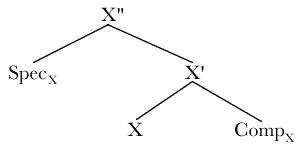I really do not know that anything has ever been more exciting than diagramming sentences.—Gertrude Stein1
The year 2007 marked the thirtieth anniversary of Jackendoff (1977), the book that made the following diagram such a part of the linguist’s life.2
(1)

The intervening 30 years have seen the X-bar provide the basis for more utterances than can be imagined3 with increasingly complex examples, such as (a personal favourite):
(2)

Unfortunately, the original English sentence has been lost, and we can only offer conjecture as to the utterer’s intent.
However, in the euphoria that X-bar diagrams have brought to linguistic studies, little thought has been given to the problem of how children acquire such diagrams. Clearly, they do not acquire them through Imitation, since few examples are to be found in their daily lives.4 Similarly, acquisition is not the result of Structured Input, or Reinforcement from the parents, since, on the one hand, children are famously oblivious to their parents’ drawings, and, on the other, few parents are even capable of expressing X-bar theory in any meaningful detail. This we may identify as the Poverty of the Stimulus argument.
Thus we are led to the inescapable conclusion that children have an innate concept of the X-bar diagram
(3)

In example (3) we see an early unlabelled X-bar diagram, identified by the child as “Daddy.” Several features are to be noted. First, we note that there are no crossing lines. This is apparently important, especially to Phonologists. The binary-
This last principle is further evident in example (4), “Daddy sleeping,” or “Daddy dead,” a transformation of (3) that retains the Periphery Principle.
(4)

Another principle is illustrated by example (5), shown with an asterisk as this is obviously not a well formed diagram.
(5)

This is a clear violation of the Head Movement Constraint.
Finally, example 6 is instructive.
(6)

(6) shows that the child is aware of the Triangle Convention, by which complicated issues not relevant to the current discussion are presented as a shorthand. This usage is particularly noted in diagrams identified as “Mommy”,6 where the entire body is shown as a triangle, indicative of Sexual Avoidance, or at least confusion on the part of the child.
Astute readers will have noticed that (6) is right-
Chomsky, Noam. Oh, just about everything.
Jackendoff, Ray, 1977. X Syntax: a Study of Phrase Structure. Cambridge, Mass: MIT Press.
McSweeney, Joann, 2005. Alexander Calder and the X-bar. Personal Communication: Facebook.
| Palinilap Cimordromic—Center Embedded Passives—Küçük Kaynaranyak Küçük | |
| Cartoon Theories of Linguistics—Part ж—The Trouble with NLP—Phineas Q. Phlogiston, Ph.D. | |
| SpecGram Vol CLIII, No 4 Contents |